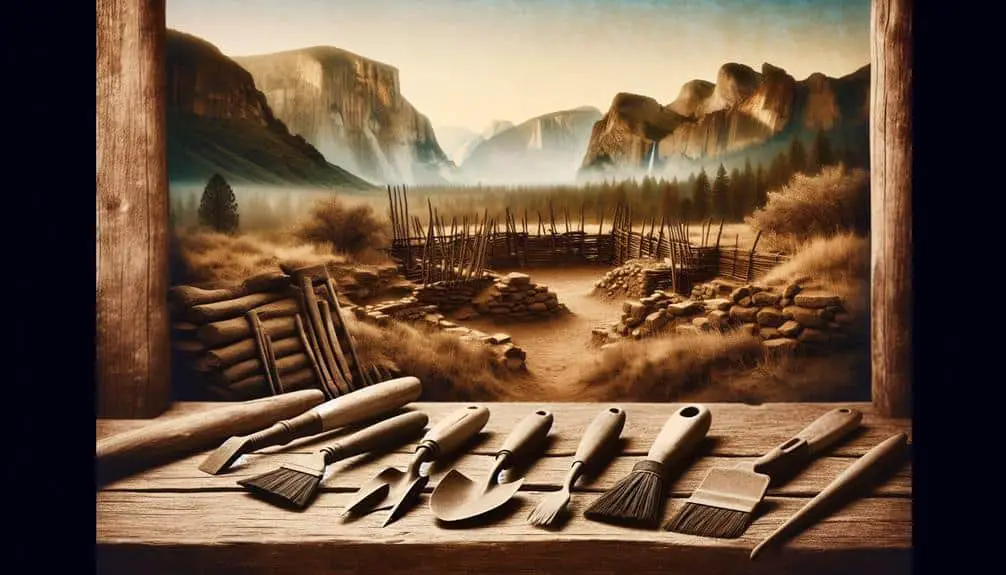Embark on an exploration of hidden Native American settlement remnants in the US to unravel a world brimming with historical, cultural, and social significance. Discover residential structures, technological advancements, and artistic expressions that offer a glimpse into the past. Uncover clues about agricultural practices, societal organization, and spiritual beliefs that enrich our understanding of indigenous heritage. Preservation efforts safeguard a tangible link to our history, highlighting the value of diversity and heritage. Delve deeper into abandoned sites to decode ancient tools, societal structures, and sacred rituals. These remnants hold the key to unlocking a treasure trove of secrets waiting to be unearthed.
Key Points
- Reveals residential structures and social organization.
- Provides insights into technological advancements and artistic expressions.
- Offers clues about agricultural practices and resource management.
- Expands knowledge of the past and honors community legacies.
- Uncover forgotten villages to understand Native American heritage.
Significance of Native American Settlement Remnants
The core of Native American settlement remnants lies in their ability to provide valuable insights into the historical, cultural, and social practices of indigenous communities. These remnants hold immense cultural significance as they offer a glimpse into the daily lives, traditions, and belief systems of Native American tribes. Through archaeological excavations, researchers can uncover artifacts, dwellings, and tools that shed light on the material culture and technological advancements of these communities.
Furthermore, the archaeological importance of these remnants can't be overstated. By studying the layout of villages, burial sites, and agricultural practices, archaeologists can piece together the socio-political organization, trade networks, and environmental adaptations of Native American societies. These findings not only enrich our understanding of the past but also help in preserving and protecting these sites for future generations to appreciate and learn from. Essentially, Native American settlement remnants serve as windows into a vibrant and diverse history that deserves recognition and respect.
Uncovering Forgotten Native American Villages
Exploring the remnants of Native American settlements often leads researchers to uncover forgotten villages that hold untold stories of past communities and their way of life. These archaeological discoveries provide valuable insights into the rich cultural heritage of Native American tribes.
- Residential Structures: Uncovering the foundations and layout of houses in these forgotten villages sheds light on the daily lives and social structures of the inhabitants.
- Artifact Analysis: Studying the tools, pottery, and other artifacts found in these villages helps researchers understand the technological advancements and artistic expressions of these ancient communities.
- Environmental Impact: Examining the impact of Native American settlements on the surrounding environment provides clues about their agricultural practices, resource management, and relationship with the land.
Unearthing these forgotten Native American villages not only expands our knowledge of the past but also honors the legacy of these communities and their enduring contributions to American history.
Preservation Efforts for Native American Ruins
Amidst the challenges of modern development and environmental pressures, preserving Native American ruins remains a critical endeavor to safeguard the cultural heritage and historical significance embedded within these ancient sites. The conservation of these archaeological treasures not only honors the past but also provides valuable insights into the traditions and ways of life of indigenous peoples. Efforts to protect these sites involve a combination of legal measures, community involvement, and scientific research to guarantee their longevity.
Archaeological discoveries within Native American ruins offer a window into the rich tapestry of history that shapes the identity of present-day societies. By safeguarding these remnants, we preserve a tangible connection to the past, allowing for a deeper understanding of the cultural complexity and resilience of Native American communities. The cultural heritage encapsulated within these ruins serves as a proof of the enduring legacy of indigenous peoples and the importance of recognizing and respecting their contributions to history. Through active preservation efforts, we not only protect these sites but also uphold the value of diversity and heritage in our collective narrative.
Exploring Mysteries in Abandoned Native American Sites
Numerous enigmatic clues lie dormant in the abandoned sites once inhabited by Native American communities, beckoning researchers to decipher their mysteries. These archaeological mysteries hold significant value in understanding the rich cultural heritage of indigenous peoples. Delving into abandoned Native American sites can reveal a plethora of secrets waiting to be discovered.
Here are some intriguing aspects to contemplate:
- Artifacts: Uncovering ancient tools, pottery, and artwork can offer insights into the daily lives and customs of these communities.
- Structures: Deciphering the layout and construction of abandoned dwellings can shed light on societal organization and architectural techniques.
- Ceremonial Sites: Exploring sacred grounds and ceremonial structures can provide clues about spiritual practices and community rituals.
Impact of Native American Settlements on US History
The significant influence of Native American settlements on US history is evident through their lasting impact on cultural, social, and political landscapes. Native American cultural influences are woven into the fabric of American society, shaping art, music, language, and traditions. Historical connections between Native American settlements and US history highlight the rich tapestry of indigenous contributions to the nation's development.
The cultural influences of Native American settlements can be seen in various aspects of American life, from the prevalence of indigenous artwork in museums to the incorporation of traditional practices in modern ceremonies. These influences serve as a reminder of the diverse heritage that forms the foundation of the United States.
Moreover, the historical connections between Native American settlements and US history shed light on the complex interactions between indigenous communities and European settlers. Understanding these connections is essential for appreciating the challenges faced by Native Americans and the resilience they've shown throughout history. By acknowledging the impact of Native American settlements, we honor the legacy of indigenous peoples and recognize their enduring contributions to the nation.
Frequently Asked Questions
How Do Researchers Determine the Age of Native American Settlement Remnants?
To determine the age of Native American settlement remnants, researchers use age determination methods like radiocarbon dating, dendrochronology, and stratigraphy. By analyzing archaeological evidence such as artifacts, structures, and soil layers, a timeline is constructed.
Are There Any Specific Rituals or Customs Associated With the Construction of Native American Settlements?
Like a weaver crafting a tapestry, Native American settlements were built with intricate construction techniques that held spiritual significance. These structures were not just homes but embodiments of cultural rituals and traditions.
What Tools and Techniques Are Used in the Preservation of Native American Ruins?
To preserve Native American ruins, conservation techniques, such as stabilizing structures, documenting findings, and limiting human impact, are essential. Archaeological excavation involves meticulous digging, mapping, and analysis to uncover and safeguard these historical sites.
Are There Any Legal Protections in Place for Native American Settlement Remnants on Private Land?
Legal protections for Native American settlement remnants on private land are intricate. Balancing land rights with preservation is vital. Consider the cultural significance and archaeological impact when managing these delicate issues.
How Do Native American Settlements Contribute to Our Understanding of Pre-Colonial History in the Us?
Native American settlements enrich our understanding of pre-colonial history by providing cultural significance and archaeological findings. They offer an important historical context from indigenous perspectives, revealing the depth of indigenous presence and influence before European arrival.



